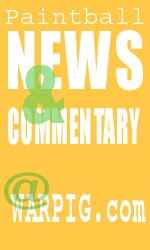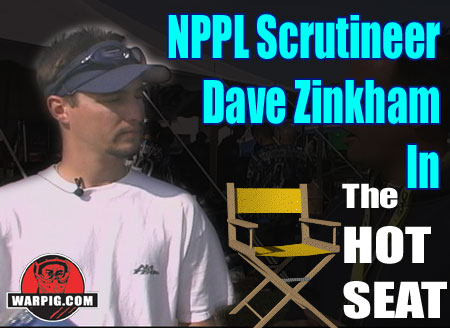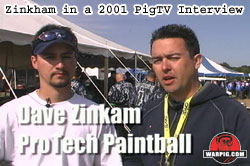  |
|
|
|
|
|
|
  |
|
|
|
|
|
|

What do you think? Add your comments in WARPIG's REC TALK Forum
|
 With paintguns becoming more technically complex, testing equipment to see if it complies with the existing rules, and making sure that rules keep up with new technology practically takes an engineer. That's why Dave Zinkham was appointed to the NPPL Rules Committee to serve as the Scrutineer for the NPPL Super 7 Series. Zinkham applies his engineering background to not only equipment inspection but also developing equipment and tests so that the rules can be applied fairly and without bias. Dave agreed to take a turn in the WARPIG Hot Seat to talk about his role in the league, and the issues faced by tournament operators in rule enforcement. OK, to start with, what is your background education/job wise? I am a mechanical engineer from the University of Pittsburgh. My experience started with pneumatics from my first job as a design engineer for a German valve company (Herion).What got you into the sport of paintball as a player, and then what led to work in the industry? I first started playing paintball in 1984. My uncle started one of the first fields in Western PA (Hamburger Hill). I played often until 91'. It's hard to play paintball and go to school. I still played recreationally until 2000, then I moved to California for a job with a pneumatic engineering company, designing systems for large companies. This is were I met Glenn Forster from Warped Sportz LA. He contacted the company I was working for in regards to a new project. Glenn and I have worked on several projects in the past 4 years. I have also worked with other companies developing new products for the paintball industry.Wow, Hamburger Hill is definitely a name old school paintballers will recognize. Do you have good stories about those early days of paintball, or how they relate to the game today? I have lots of great memories of the field, but I guess what I miss most is playing 100 on 100 with everyone using SplatMasters in the woods. That was real paintball to me!What products have you developed for paintball? In the last several years I have developed electronic AutoCocker frames, regulators, markers and my favorite the Drop Kick. It is a device that mounts between your frame and drop forward, that enables you to move yourWhat is your current occupation? Today I work for myself doing engineering projects out of my home in PA.In the NPPL Super 7 Series you serve as the league's scrutineer. What exactly does that entail, and how did you get selected for the position? As a volunteer working to keep the competitions fair for the players, do you ever feel unappreciated by the people you face at tournaments? Sure I do all of the time. I understand that the league is growing so rapidly that it's hard to keep track of everyone. I do not do this for the glamour or praise. Only the satisfaction that the best teams are victorious.As scrutineer do you assess penalties directly, or act as a technical consultant examining equipment and giving your judgment to a referee or the ultimate judge? I do have the power to assess penalties, but I choose to let my buddy Phil Dominguez do it.In addition to testing equipment to see if it conforms to the rules, you have some input on the development of new rules as well. Does that come in the form of feedback to the rules committee, or do you hold a voting position on the rules committee? I do have input on new rules, how much is to be seen. I do hold a voting position on the rules committee and enjoy attending meetings, there is a lot of paintball knowledge in the room with legends like: Phil Dominguez, Glenn Forster, Ron Kilborn, Tommy Cole, Pete Robinson and Chuck.Writing rules that can be fairly and evenly applied, and keep up with changing technology is not an easy task at all - and sometimes a well meant rule can end up being unenforceable. For several years the NPPL rules have prohibited staining paint, but no paints had ever been specifically blocked from use at events. The main problem with enforcing that rule was that there wasn't a clear definition as to what paint stained, and surely if one brand was excluded the teams using it would claim the decision was arbitrary and unfair. In the 2003 season the NPPL rules made huge progress by actually defining staining paint, with a test to determine if any paint stains too much to be allowed. This was so good in concept that NPPL 2003 Rule Appendix A (staining paint test) was copied almost directly into PSP's 2004 rules as Appendix A. A problem came up in applying the rule though. At NPPL Miami 2003, one of PMI's paints was initially rejected, but your testing showed that all of the paint available for sale at the event failed the staining test, and obviously prohibiting all of the paint wasn't an option as that would stop the tournament. Now the 2004 NPPL rules have dropped Appendix A, and section 14.01 says that the paintballs used must meet the NPPL non-staining criteria. What is the new criteria for this season, and have there been any specific paint brands which do not meet it? Rule 14.01 for 2004 also changes the NPPL from its previous bring your own paint format to field paint only tournaments (albeit with a wide enough selection of brands to choose from that few, if any teams should be affected) by restricting paint to that which is purchased on site from NPPL paint sponsors, and for those which the manufacturers have supplied the league with materials safety data sheets. The league web site doesn't presently list which sponsors are paint sponsors or which brands from those sponsors have MSDS sheets on file, as well as which pass or fail the new stain criteria. What is the best way for a team or player to find out which paint brands will be available and approved at an event? This was only for the Huntington Beach event, because the city was so strict. The teams that want to bring there own paint must get the paint manufacturer to conduct the paint test and to sign a waver before the event. If teams are found with paint that was not cleared by the NPPL, the fine is quite stiff.  Similarly
rule 10.01 allows only goggle systems for which the manufacturer has submitted
proof of an independent lab test proving that their product meets ASTM
standards, at least 10 days prior to the event. While this rule has
been around for years, the league formerly lacked a scrutineer to check
up on these things and the previous ultimate judge didn't do the record
keeping to enforce it. What is the best way for teams to be able
to check to see which goggles are allowed, and have certifications on file
with the league? Similarly
rule 10.01 allows only goggle systems for which the manufacturer has submitted
proof of an independent lab test proving that their product meets ASTM
standards, at least 10 days prior to the event. While this rule has
been around for years, the league formerly lacked a scrutineer to check
up on these things and the previous ultimate judge didn't do the record
keeping to enforce it. What is the best way for teams to be able
to check to see which goggles are allowed, and have certifications on file
with the league?
Players can contact the NPPL office for a list of certified goggle systems.As you define it, what is "trigger bounce?" I was afraid that this questions would come up. I feel that there are several types of bounce in a marker. The first being "switch bounce". This being when the micro switch in the marker is either worn out or someone changes the manufacturers design. Switch bounce is when contacts of the micro switch close to fire the marker and when the switch is released the marker may fire again, do to the long arc that [occurs] during opening.Answering about trigger bounce may be tough, but it's very valuable. One of the reasons your position is so important, and progressive is that with past leagues and event producers, players have often had to face arbitrary decisions on equipment legality. You've put forth a serious effort to help more clearly define equipment rules as well as develop tests and test equipment. Any time a rule or product regulation is broken down into something that can be measured, where the measurement can be witnessed by multiple people, as opposed to a referee trying something and making a subjective decision, it's a lot easier to enforce impartially. It also helps players not be surprised by thinking a piece of equipment is legal only to have it excluded at an event - or to face an opponent who is using something they though would not be legal and have it allowed. What is a ramping rate of fire as opposed to adding shots? If the robot pulls the trigger lets say 10 times, and 10 shots are fired, what would ramping of the rate of fire do? Good question! It is not likely this will happen but it is possible. Say the robot pulls the trigger: 10 shots @ 12 bps. The board could store the shots and shoot the marker at 10 shots @ 18 bps. or what ever it is programmed to do.You mentioned increasing velocity as one of the most important gun cheats to catch, because it is a safety issue. I have discussed the idea with Al Dilz, the designer of the Paintball Radar Chron, and he believes it is feasible to develop a more compact chronograph that could be strapped below the barrel and measure the velocity of every shot a player takes during a game, emitting a warning to refs if they shoot hot. Do you think that would be a good way to go if the technology becomes practical? I would love to see this technology. I get off on new gadgets like this. I am sure that the NPPL would be interested in it. Anything to keep the insurance companies happy is a great thing.You had mentioned in a previous conversation that you have undertaken the expense of designing and building this test equipment yourself. Something that I don't think many players realize, especially when something is not going their way at a tournament, is how many people in different levels of the sport do things like this simply to improve the game for everyone, not for a financial reward. The NPPL has paid for some of the more expensive parts. Without their help this project would not be as far as it is right now.At what point is a trigger bouncing so much that it's no longer legal in the NPPL? I believe that it all comes down to consistency. The NPPL has made efforts to have ONE person be the judge of bounce, me. The chrono judges are instructed to test for bounce before each game, if they have a questionNPPL press releases pointed highlighted your new trigger pulling robot making its debut at Huntington Beach this year. What does the robot do to a paintgun, and what does it record from the paintgun? I designed to Robot not because of bounce but because of cheater boards. The marker is placed on a marker stand and the robot will pull the trigger at any rate of fire and for any number of shots. The marker is shot over aWhen we say "robot" I think that conjures something like C-3PO from Star Wars in some peoples minds. What does the test robot look like? First we must define "robot". My definition is: a mechanical device that has full motion control. This does not state the number of axis that it must have. My robot is a single axis rotary servo motor with smart feedWhat types of "cheats" or set up problems is the robot meant to catch? The robot will catch the following cheats: Adding Shots, Ramping Velocity, Ramping Rate of Fire. Ramping of Velocity is the one that I am most concerned with. This can seriously injure a player.Did the robot help catch paintguns in Huntington Beach that weren't legal under the NPPL rules? I only had a little under 3 weeks to complete the project, so the robot was still in testing at the event. I did check quite a few markers and had some interesting results. It will be completely ready for Tampa.I personally classify electronic gun cheats into two categories. In the first, it's a user cheat. That is where the user takes their paintgun and adjusts its settings into a way that is not legal at the tournament, such as turning a debounce setting lower than is allowed, or leaving an internal mode lock open so that they can change modes during a game. The second is a cheat mode built into
the software that runs the gun, where the gun is literally designed to
cheat - a true cheater board. One example - which I will not name
to protect the anonymity of the retired pro player who explained it to
me and which I have verified by testing a gun used a few years ago by that
retired player's team - is switching to an illegal mode by tapping a code
on the trigger. After a few seconds of not being fired, the gun would
automatically revert to legal semi-auto. Since a cheat like this
is hidden in software, the board looks no different than a perfectly legal
board, and unless the cheat mode turned on at the time of testing it won't
be seen, and it can only be turned on if the combination is known.
Do you have a strategy in for exposing this
We are trying new things at the events. Last event, if I thought a team was suspicious I would tell the on field refs that once a certain player was eliminated to take his marker immediately so that I could test it. I also told them to make sure that they did not touch the marker once the ref told them that they wanted to see the marker. If so the player was going to be suspended for a couple of games. We did tell all of the teams this at the captains meeting before the tournament. This is why it is so important for all team to attend it. I am trying to make the captains meeting mandatory, but that's another subject.Right now, what do you think the biggest challenge is to tournament paintball - not just in the NPPL, in regards to enforcing equipment rules? I truly believe that the biggest challenge for paintball is educating the public of our sport. Especially since the accident in northern California this year. Insurance companies are doubling premiums, not renewing policies or even canceling policies. Without insurance tournament paintball will not exist!!! Paintball has to come together as a whole and unite, educating people. This is not an easy or an inexpensive task, but it must happen.Thank you Dave, for taking the time out for this interview, as well as for the time and effort you put into defining and enforcing equipment rules for the NPPL. It's definitely refreshing to see the approach that you have taken - developing rules and procedures that can allow for controlled testing for even and fair enforcement. For a peek at a previous interview with Dave Zinkham, watch the World Cup 2001 episode of PigTV, where Dave talks about the Protech electronic trigger system. |
| Copyright © 1992-2019
Corinthian Media Services. WARPIG's webmasters can be reached through our feedback form. All articles and images are copyrighted and may not be redistributed without the written permission of their original creators and Corinthian Media Services. The WARPIG paintball page is a collection of information and pointers to sources from around the internet and other locations. As such, Corinthian Media Services makes no claims to the trustworthiness or reliability of said information. The information contained in, and referenced by WARPIG, should not be used as a substitute for safety information from trained professionals in the paintball industry. |